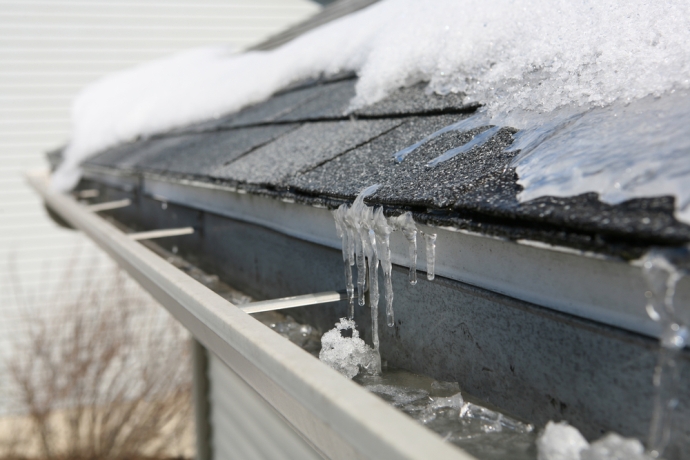
Roof leaks can occur for a variety of reasons. They typically start out small and grow over time to be larger problems. That said, even a small roof leak can cause major damage to your home. Besides forming wet stain spots on your finished ceilings, roof leaks can cause mold and mildew growth and rot. They even can cause electrical shorts.
Checking for roof leaks can be a little tricky. They are typically not found directly above the damaged ceiling area. Roof leaks tend to start higher on a roof and show their symptoms further down the roofline.
Leaks Caused by Ice Dams
In the case in which the roof leak signs are exhibited near the interior edge of your exterior walls, chances are the leak is associated with cold weather conditions — more specifically, ice dams. Ice dams back up water behind shingles, where the water finds a path through the roof sheathing and then gets to the drywall ceiling. To find the path, the water works its way down the roof sheathing until it finds a loose nail or a seam.
To prevent ice dams, plan on either shoveling off the snow along the edges of the roof after every major snowstorm or adding heating coils along the edge of the roof. You may want to consider having the roof re-shingled so you can install an ice and water shield near the roof eves. Also, make sure your attic is properly ventilated and insulated.
Leaks Caused by a Damaged Ridge Vent
If signs of a roof leak are exhibited more toward the center of the room, then there is the possibility that it is associated with a damaged ridge vent. In many cases, wind can work ridge venting loose and pop roofing nails loose. Check the ridge vent to make sure that it is fastened down properly and that the roofing nails are covered with a roofing sealer.
Also note that water that penetrates into the attic and onto the ceiling can meander its way along strapping. Strapping is commonly used to fasten drywall perpendicular to ceiling joists. If you see a long wet line on your drywall ceiling, it is probably because water has run along a length of strapping.
Leaks Caused by Damaged Shingles
Another possibility if signs of a roof leak are exhibited more toward the center of the room is you have damaged shingles. Inspect the roof for shingles that are curling, cupping and/or cracked. Those shingles could very well be the source of your roof leak and should be replaced immediately.
Leaks in Roof Valleys
If your roof has valleys, make sure the shingles are not damaged in these areas. If copper or tin is used for forming the roof valleys, make sure that it is not damaged in any way and that there are no loose or exposed nails. The wrong types of nails used for installing copper flashing can also cause corrosion, which can lead to roof leaks.
Leaks Near Roof Flashing Areas
Check roof flashing around and near vent stacks, chimneys and roof/wall lines. Make sure the flashing is not damaged or blocked in any way with leaf debris or snow and ice, which can cause water to back up and work its way underneath the flashing. If the flashing looks damaged, have it replaced immediately.
This article was contributed by Mark Donovan.
 Related Articles & Free Subscription
Related Articles & Free Subscription
Easy Ways to Enhance Your Home’s Accessibility
Quick, Easy Fix-Ups To Make Your Home Look Better and Sell Faster






Comment here